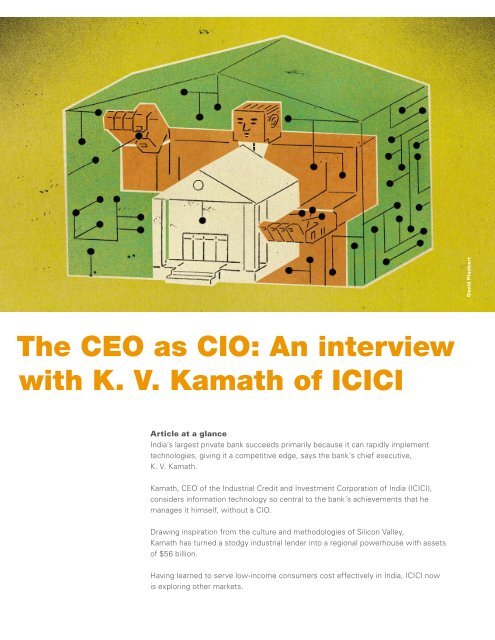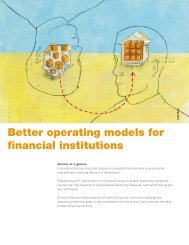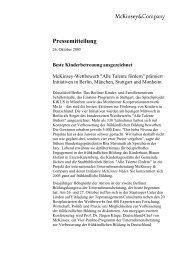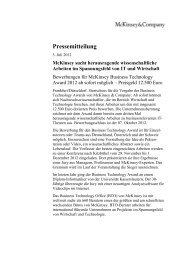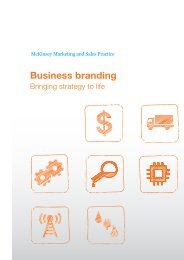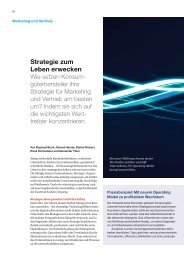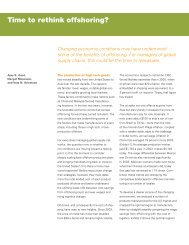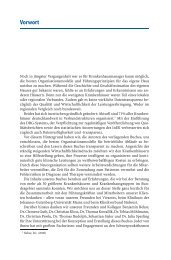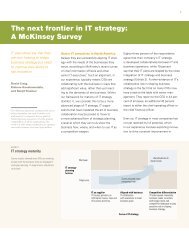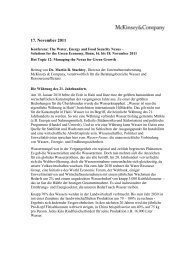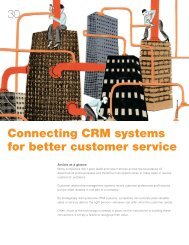The CEO as CIO: An interview with KV - McKinsey & Company
The CEO as CIO: An interview with KV - McKinsey & Company
The CEO as CIO: An interview with KV - McKinsey & Company
You also want an ePaper? Increase the reach of your titles
YUMPU automatically turns print PDFs into web optimized ePapers that Google loves.
<strong>McKinsey</strong> on IT Spring 2007<br />
<strong>The</strong> <strong>CEO</strong> <strong>as</strong> <strong>CIO</strong>: <strong>An</strong> <strong>interview</strong><br />
<strong>with</strong> K. V. Kamath of ICICI<br />
Article at a glance<br />
India’s largest private bank succeeds primarily because it can rapidly implement<br />
technologies, giving it a competitive edge, says the bank’s chief executive,<br />
K. V. Kamath.<br />
Kamath, <strong>CEO</strong> of the Industrial Credit and Investment Corporation of India (ICICI),<br />
considers information technology so central to the bank’s achievements that he<br />
manages it himself, <strong>with</strong>out a <strong>CIO</strong>.<br />
Drawing inspiration from the culture and methodologies of Silicon Valley,<br />
Kamath h<strong>as</strong> turned a stodgy industrial lender into a regional powerhouse <strong>with</strong> <strong>as</strong>sets<br />
of $56 billion.<br />
Having learned to serve low-income consumers cost effectively in India, ICICI now<br />
is exploring other markets.<br />
David Plunkert
Leo Puri<br />
Information technology is so crucial for the<br />
success of India’s top private bank that the <strong>CEO</strong> says<br />
he oversees it himself.<br />
Little more than a decade ago, the Industrial Credit and Investment Corporation<br />
of India (ICICI) w<strong>as</strong> a vulnerable institution whose primary purpose w<strong>as</strong> to provide<br />
industrial loans to support India’s economic development. Today, <strong>with</strong> <strong>as</strong>sets around<br />
$56 billion, ICICI Bank is the country’s largest private bank, <strong>with</strong> a v<strong>as</strong>t consumer<br />
b<strong>as</strong>e served from more than 614 branches and 2,200 ATMs in 13 countries. K. V. Kamath,<br />
who became managing director and <strong>CEO</strong> in 1996, attributes the bank’s success largely<br />
to innovations in its use of technology. Borrowing from Silicon Valley, Kamath h<strong>as</strong><br />
encouraged the rapid development and implementation of technologies that enable<br />
ICICI to serve v<strong>as</strong>t numbers of customers. He also h<strong>as</strong> begun exploring ways to serve<br />
the “unbanked,” the lowest-income groups, which constitute much of the emerging<br />
market’s population.<br />
With an aggressive strategy that some observers see <strong>as</strong> bordering on audacity, the bank<br />
h<strong>as</strong> moved confidently and rapidly to integrate changes in the way it serves customers<br />
(ramping up its reliance on ATM and Internet usage) and runs its back-office operations<br />
(<strong>with</strong> inexpensive software development and hardware), all while keeping technology costs<br />
at a fraction of those at other large banks. Kamath views IT <strong>as</strong> so critical to the bank’s<br />
growth that, rather than delegate to a <strong>CIO</strong>, he manages the bank’s technology himself.<br />
Kamath discussed the bank’s journey, and technology’s role in it, <strong>with</strong> <strong>McKinsey</strong>’s Leo<br />
Puri at ICICI’s modern campus in Mumbai.
<strong>McKinsey</strong> on IT Spring 2007<br />
<strong>McKinsey</strong> on IT: How did ICICI transform itself from a development bank to India’s<br />
largest private bank?<br />
K. V. Kamath: We started out in the mid-1950s, when the World Bank w<strong>as</strong> trying to<br />
kick-start economic development. In those days development banking b<strong>as</strong>ically meant<br />
lending to industrial enterprises. We were a listed company right from the beginning,<br />
<strong>with</strong> participation by domestic banks, insurance companies, and global banks. F<strong>as</strong>tforward<br />
40 years, and India had opened up. Economic reform w<strong>as</strong> under way, global<br />
forces were at work, and a market economy w<strong>as</strong> starting to evolve. All of a sudden, Indian<br />
corporations were under pressure to perform. Most of them were our customers, and<br />
a lot of them got sick and turned into nonperforming <strong>as</strong>sets.<br />
We looked around and decided that consumer credit w<strong>as</strong> going to be the next big<br />
opportunity in India. Once per capita income in a country reaches $450 to $500, you<br />
tend to see consumer activity take off: consumer durables, cars, homes. We thought<br />
we could enter credit by leveraging our core competency—the ability to use technology.<br />
We had no competency in banking because we were a term lender, not a retail player.<br />
Nor did we have any products, or distribution, or processes, or people. In fact, we had<br />
nothing except confidence in our ability to use technology and leaders whom we<br />
thought could drive the business.<br />
K. V. Kamath<br />
Vital statistics<br />
Born December 2, 1947, in<br />
Mangalore, Karnataka, India<br />
Married <strong>with</strong> 2 children<br />
Education<br />
Graduated in 1969 <strong>with</strong> BS in<br />
mechanical engineering from<br />
Karnataka Regional Engineering<br />
College in Surathkal, Karnataka,<br />
India<br />
Earned MBA in 1971 from<br />
Indian Institute of Management<br />
Ahmedabad<br />
Career highlights<br />
ICICI Bank (1996–present)<br />
• Managing director and <strong>CEO</strong><br />
Asian Development Bank (1988–96)<br />
• Joined in private-sector department; worked on<br />
projects throughout south and e<strong>as</strong>t Asia;<br />
represented bank on boards of several companies<br />
ICICI (1971–88)<br />
• Served <strong>as</strong> head of le<strong>as</strong>ing operations, head of<br />
resources and tre<strong>as</strong>ury operations, and executive<br />
<strong>as</strong>sistant to then-chairman S. S. Nadkarni<br />
• Set up strategic-planning division; planned<br />
diversification into new business are<strong>as</strong> of investment<br />
banking, venture capital, and credit rating<br />
• Initiated and implemented ICICI’s computerization<br />
program<br />
F<strong>as</strong>t facts<br />
Member of the National Council of the Confederation<br />
of Indian Industry<br />
Serves on board of Visa International and on<br />
boards of several educational institutions, including<br />
Indian Institute of Management Ahmedabad<br />
Enjoys watching auto racing and cricket, playing tennis,<br />
reading
<strong>The</strong> <strong>CEO</strong> <strong>as</strong> <strong>CIO</strong>: <strong>An</strong> <strong>interview</strong> <strong>with</strong> K. V. Kamath of ICICI<br />
<strong>McKinsey</strong> on IT: It seems that innovation h<strong>as</strong> been central to ICICI right from the<br />
start. Where did that innovative spirit come from?<br />
K. V. Kamath: It w<strong>as</strong> all about survival. Our core franchise w<strong>as</strong> crumbling and we were<br />
right on the edge, so we had to reinvent ourselves. We looked at where our strengths<br />
lay and focused on them. It’s e<strong>as</strong>ier to take risks when you’re in the position we were in.<br />
I guess that’s what sparked our innovative and entrepreneurial instincts.<br />
<strong>McKinsey</strong> on IT: That may explain why you started out being innovative, but how<br />
have you managed to sustain it?<br />
K. V. Kamath: You’re absolutely right: once you’ve t<strong>as</strong>ted success, it’s e<strong>as</strong>y to let go.<br />
That’s where culture comes in. You need to take that innovative spirit and push it<br />
to a level where change, learning, and knowledge sharing become a regular part of your<br />
company’s culture. We also make a point of not allowing silos to grow. I tell people that<br />
if I see a silo, I’m going to take a big stick to it. If you don’t do that, silos grow, they get<br />
set in stone, and you find you can’t do business anymore. Once you get into a mainframe<br />
mind-set, say, you start building rigid structures. From day one, our philosophy w<strong>as</strong> “no<br />
mainframes.” Without them, you can move freely.<br />
<strong>McKinsey</strong> on IT: Where did execution figure in your strategy?<br />
K. V. Kamath: In the late 1990s, garage start-ups in Silicon Valley were taking<br />
products from concept to market in 90 days because if they didn’t, somebody else would.<br />
So we <strong>as</strong>ked, “Why can’t we?” We made it a rule: no project w<strong>as</strong> to extend beyond<br />
90 days. People were skeptical at first, but it w<strong>as</strong> achievable, and it gave us a huge com-<br />
petitive edge. When I first heard about the 90-day rule at a seminar, we were build-<br />
ing a platform for online brokerage almost from scratch. I got on the phone to Bombay<br />
from New York and said, “We need to get this done in 90 days.” <strong>The</strong> project had<br />
already been going for 30 days, so in the end I said, “OK, you can have 90 days from<br />
today.” <strong>The</strong> trading platform w<strong>as</strong> up and running 90 days later. It cost us just over<br />
$1 million, and <strong>with</strong> some marginal tweaking—nothing more—it is still operating today.<br />
When you give people a challenge and show them that other people have tackled it, they<br />
find solutions. If they are bright and have the b<strong>as</strong>ic tools, why shouldn’t they?<br />
<strong>McKinsey</strong> on IT: Who is responsible for technology at ICICI?<br />
K. V. Kamath: I am. It’s my neck on the line. If the technology fails, it’s my fault; if<br />
it succeeds, then good for the organization. We decided we had to run technology in a<br />
radically different way from anyone else, so we don’t have a technology department<br />
or a glorious title like chief information officer. <strong>The</strong>re is no <strong>CIO</strong>. Technology is embedded<br />
in every business, and the head of the business runs the technology.<br />
You might <strong>as</strong>k, “Doesn’t this lead to anarchy? Who makes sure that there aren’t a zillion<br />
servers, and a zillion different models, and so on?” Well, we created a small group—<br />
fewer than a dozen people, average age 28—that reports to me. <strong>The</strong>y aren’t bureaucrats;
0<br />
<strong>McKinsey</strong> on IT Spring 2007<br />
they don’t have any decision-making authority. But any critical plan in technology,<br />
whether it’s hardware or software, is put to them.<br />
<strong>McKinsey</strong> on IT: How did you convert your ability to use technology into a competi-<br />
tive advantage?<br />
K. V. Kamath: User technology is a mind-set issue, but it can get turned into a structural<br />
issue because the platforms and the people around them make you rigid. Here, we have<br />
no excuse. We want technology that allows us to migrate. Mainframes would have locked<br />
us in. <strong>An</strong>other call we took w<strong>as</strong> that people would use technology even in a country<br />
like India. At a time when there were fewer than 100 ATMs in the whole country, we said<br />
we would roll out 1,000 ATMs in the first year. People thought we were mad. Who<br />
would use them? How would we get connectivity?<br />
<strong>The</strong> networks here are fragile, so we had to run ATMs at three levels of redundancy, <strong>with</strong><br />
a dial-up line, a le<strong>as</strong>ed line, and a satellite link sitting on top of the whole thing to<br />
make it at le<strong>as</strong>t 99 percent reliable. As for the customer, what the skeptics hadn’t noticed<br />
w<strong>as</strong> that convenience w<strong>as</strong> becoming a priority. People didn’t have all the time in the<br />
world to walk to a bank, stand in line, get served, and come out again. <strong>The</strong>y didn’t mind<br />
learning to use a bit of technology. It w<strong>as</strong>n’t rocket science. So we kept pushing the<br />
envelope. Will customers accept the Internet <strong>as</strong> a mainline channel? What about call<br />
centers? <strong>An</strong>d mobile telephones? <strong>The</strong>y answered yes every time.<br />
To put this in context, we had about 100,000 banking customers in 2000; today we have<br />
close to 20 million. Six years ago, maybe 95 percent of all transactions took place in<br />
the branch and 5 percent at the ATM. Now branch transactions are down to 15 percent,<br />
ATMs have gone up to 48 percent, the Internet is 21 percent, and the call center is<br />
5 percent. Instruments that go directly to the back office for processing, <strong>with</strong>out hitting<br />
a branch, account for about 10 percent.<br />
<strong>An</strong> amazing transformation h<strong>as</strong> taken place. Customers are telling us they want to<br />
change. If their bank doesn’t change <strong>with</strong> them, they will be looking for a new bank.<br />
<strong>McKinsey</strong> on IT: How have you managed to change <strong>with</strong> the customer when your<br />
competitors haven’t?<br />
K. V. Kamath: Every other bank w<strong>as</strong> skeptical about technology. I can’t claim we<br />
invented anything for ourselves. <strong>The</strong>re were global banks at the time that were<br />
considering using lots of ATMs <strong>with</strong> a lean branch structure and a thick technology<br />
structure. <strong>An</strong>d in India, one bank said in the late 1990s that it would adopt ATMs and<br />
have maybe 30 of them around one branch. We thought that looked interesting, and we<br />
worked out that we could break even in less than two years. So we scaled up. Nobody<br />
else did. We got a head start for the next three or four years, and then everybody started<br />
scrambling, but by then it w<strong>as</strong> too late. We were embedded.<br />
<strong>The</strong> same thing h<strong>as</strong> happened in every business. When we said consumer credit is the<br />
next growth opportunity, nobody believed us. We prepared a different structure for
<strong>The</strong> <strong>CEO</strong> <strong>as</strong> <strong>CIO</strong>: <strong>An</strong> <strong>interview</strong> <strong>with</strong> K. V. Kamath of ICICI<br />
it: no branches but a hub-and-spoke structure <strong>with</strong> franchisees. We decided to work <strong>with</strong><br />
partners who had credit scoring and run it centrally. That w<strong>as</strong> completely different<br />
from what most players were doing here. Luckily for us, it turned out to be the right model.<br />
<strong>McKinsey</strong> on IT: When you explore new businesses, do you do it in the knowledge<br />
that some may not succeed?<br />
K. V. Kamath: When we build a business, we put in enough diligence to make sure<br />
it succeeds. So <strong>as</strong> a b<strong>as</strong>e c<strong>as</strong>e, we don’t allow for failure. We are pretty paranoid about<br />
what will happen next, though, particularly in terms of business models. Take cell<br />
phones. Are they going to change the way customers interact? Will banks face a new<br />
challenge from payment systems that can be embedded in mobile phones and man-<br />
aged by the telephone companies?<br />
<strong>The</strong>re are lots of other issues. Could supermarkets turn out to be a threat to banks?<br />
If so, in what way? What is the regulatory context? <strong>An</strong>d the technology context? You<br />
need to have a contingency strategy, and that’s where threats can lead to success.<br />
A word we like to use at ICICI is “disrupt.” We are comfortable adopting disruptive<br />
strategies and using the technology to disrupt.<br />
<strong>McKinsey</strong> on IT: You’ve said your technology costs are 10 percent of those at other<br />
banks. How have you achieved this?<br />
K. V. Kamath: <strong>The</strong>re are two or three elements. <strong>The</strong> first is hardware. Using<br />
systems that allow you to migrate to more efficient systems <strong>as</strong> you go along brings down<br />
costs dramatically.<br />
Software is another key part. We work <strong>with</strong> vendors who recognize that our running costs<br />
are a challenge. If a particular vendor is inflexible about pricing, fine, let’s discuss it. But<br />
if we can’t resolve it, I will migrate to a different partner who can give me the product at<br />
a price I can afford. You won’t believe this, but most of the time the cost of replacement<br />
software is only 10 percent of the original cost. So it costs me less to put in new software<br />
than to pay the maintenance contracts on my old software.<br />
<strong>The</strong> third part of the equation is talent. A software professional in India probably costs<br />
about a fifth to a tenth of what you would pay elsewhere. Add them all up, and these are<br />
the things that make the equation work.<br />
<strong>McKinsey</strong> on IT: Recently, ICICI h<strong>as</strong> branched out into many new financial services.<br />
What’s the philosophy behind your diversification?<br />
K. V. Kamath: After we got consumer credit right, we looked around for other oppor-<br />
tunities that might arise in a country that is opening up. We found a whole load of<br />
them: insurance (life and nonlife), private equity and venture funding, securities, invest-<br />
ment banking—all were ready to open up. Three years ago, we also started looking<br />
at the needs of Indians abroad. <strong>The</strong>re are many individuals and companies doing twoway<br />
trade or acquiring companies abroad. So we opened up branches, subsidiaries,
<strong>McKinsey</strong> on IT Spring 2007<br />
and rep offices across the Americ<strong>as</strong>, Europe, the Middle E<strong>as</strong>t, and Southe<strong>as</strong>t Asia.<br />
In the next year or so, between 20 and 25 percent of our balance sheet and profits will come<br />
from international operations.<br />
<strong>The</strong> next big horizon is something that strikes a chord <strong>with</strong> almost any banker anywhere in<br />
the world, even in developed countries. I call it “banking for the unbanked.” <strong>The</strong>re are<br />
600 million people in India <strong>with</strong> no banking facilities at all. <strong>The</strong>y live in 600,000 villages<br />
spread over 600 districts. Can we take banking out to them?<br />
<strong>The</strong>re’s no point setting up shop to take in deposits; they don’t have any money. You have<br />
to learn to lend to them and create a worthwhile opportunity for them to make some<br />
money. That could lead to a savings product, and maybe after that you can lend to them<br />
for a small home, for things to put in it, and so on. One product leads to another.<br />
We believe this will require new technology platforms at a fraction of the costs of our<br />
current technology. A new delivery architecture is needed too—not b<strong>as</strong>ed on branches,<br />
but using a partnership model. To work in 600 districts, we’ll need at le<strong>as</strong>t 200 microcredit<br />
institutions, each working on 3 districts.<br />
<strong>McKinsey</strong> on IT: H<strong>as</strong> your global strategy evolved beyond serving Indians abroad?<br />
K. V. Kamath: Initially, it w<strong>as</strong> nonresident Indians and Indian businesses that took us<br />
abroad. But once we were there, we found we could leverage our other competencies.<br />
If we are able to run technology for 10 percent of what it costs other banks and handle<br />
a large volume of customers online, why shouldn’t we roll out Internet banking in<br />
the other countries where we operate, like Canada? We started rolling out the platforms<br />
about eight months ago. By back-ending costs to India, we’ve found we can save<br />
around 75 b<strong>as</strong>is points in operating costs, and we are p<strong>as</strong>sing part of that to the customer<br />
in higher deposit rates so that people are happy to come to us. We have a model that<br />
we think we can scale up across Canada, the United Kingdom, at le<strong>as</strong>t two or three count-<br />
ries in Europe, and maybe one or two countries in the Far E<strong>as</strong>t.<br />
<strong>An</strong>other thing we hadn’t planned for w<strong>as</strong> the ability to cross-sell products to Indians<br />
abroad. Take technology workers: they all believe they will be coming back to India<br />
before long, so they want homes, and we can provide them <strong>with</strong> the financing. Or take<br />
the people who left in the 1970s; now they are looking for second homes in India. So<br />
the global opportunities are looking much bigger and more interesting than they did at<br />
the beginning. MoIT<br />
Leo Puri (Leo_Puri@<strong>McKinsey</strong>.com)<br />
is a partner in <strong>McKinsey</strong>’s Mumbai<br />
office.<br />
Copyright © 2007<br />
<strong>McKinsey</strong> & <strong>Company</strong>. All rights<br />
reserved.


